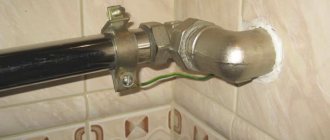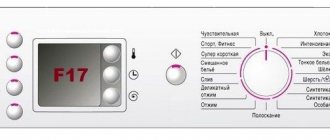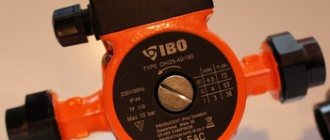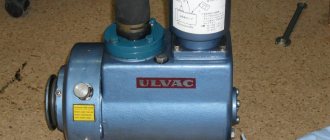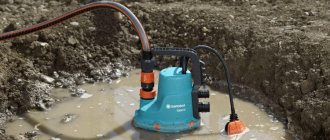A water supply pumping station is equipment designed to organize an autonomous water supply in private homes, country cottages, dachas, along with circulation pumps. The unit supplies water from the hydraulic accumulator and maintains the specified pressure in the water pipelines. The design includes:
- self-priming deep or surface pump;
- an electric motor connected electrically to the pressure switch and mechanically to the pump itself;
- relay for adjusting the pressure in the water supply and setting up the unit;
- a device for measuring pressure, monitoring parameters and adjusting them during operation;
- a hydraulic accumulator divided by a membrane into two working chambers - air and gas.
When the pressure in the system drops below the specified level, the pump turns on and the liquid is pumped into the storage tank. When the set upper pressure value is reached, the pump turns off. The design of the pumping station allows the equipment to be turned on only when the pressure drops to the specified values, and not every time the valve at the water intake point is opened.
Operating principle
Water supply pumping stations for a private home carry out the labor-intensive process of supplying liquid. Can be used for water supply to homes, utility rooms, filling tanks, swimming pools, and irrigation. But in order for the device to meet all the requirements, it is necessary to choose the right model with the appropriate characteristics.
A source in a suburban area can fully provide water to a house, garden, territory and vegetable garden. For uninterrupted supply of liquid and normal functioning of the system, it is necessary to carefully consider the water supply process and select the appropriate station. To do this, it is better to contact the appropriate specialists. But you should also familiarize yourself with useful information on choosing a device.
Model with a large tank Source strojvodproekt.ru
The operating principle of the pumping station is very simple. Liquid supply is carried out in several ways:
- Pumping equipment and a hydraulic accumulator are used. The best option in the absence of a centralized water supply and for permanent residence. Gives maximum effect, supplies water to the house and other objects. Provides high productivity and efficiency.
- Use of pumping equipment and a special tank. The tank itself is mounted in the upper part of the building. It is necessary to insulate the room, strengthen the floors and high-quality waterproofing. Allows you to have a constant supply of water. The pump is turned on rarely - only to fill the container.
- Supply through the pump directly to consumers. The equipment is turned on frequently, as a result the device does not last long. But at the same time, a medium-power model is sufficient. The simplest models are suitable for small areas or seasonal use.
Connection diagram to the well Source strojdvor.ru
When choosing, you must carefully study all the characteristics. The device’s throughput and compliance with the necessary requirements depend on them. In some cases, an additional pump is required to maintain pressure parameters. When using a large number of devices, the complexity of the system and the likelihood of breakdown increases.
Selecting a pumping station for water supply
The selection of equipment for arranging an autonomous water supply system is made based on the level of consumption and technical characteristics of the device (performance, power, volume of hydraulic accumulator). For example, a small automatic pumping station of medium power with a storage tank pumps an average of m³/h, which makes it possible to organize high-quality water supply for a family of 3-4 people.
When choosing a centrifugal pumping station for arranging water supply, the following also play an important role:
- well flow rate;
- height of the post at the fence point;
- distance of the source from the place of consumption;
- water quality and degree of purity.
If the above parameters are not taken into account when selecting equipment, there may be a shortage of water supply (interruptions in the supply of water, a decrease in pressure in the system, frequent switching on/off of equipment) or an excess of it, which is also undesirable, since this can lead to a drop in the water surface. source and even to its drainage.
Device principle
Before choosing water supply pumping stations for a private home, you need to understand the type of their device. The unit can be assembled separately or purchased as a ready-made model. It may consist of the following elements:
- hydraulic accumulator (special tank, which can be from 15 to 100 liters or more);
- automation, adjustment blockers;
- hoses, fittings, pipes, valves;
- check valve;
- pump (surface/submersible model is used);
- filter;
- pressure switch.
Experts always advise choosing ready-made models, where the elements are selected according to all characteristics. Submersible models can be changed to surface models.
Station design Source strojdvor.ru
The filter is used to protect the device from debris. The valve protects against liquid backflow when the device is turned off. The pump turns off/on according to the signal from the pressure switch. The cross-section of the pipes must ensure normal movement of liquid. Powerful models provide a normal supply of liquid for houses where more than 5 people live, as well as water intake points outside the house.
Main components
A pumping station for a private home is an excellent solution for automating water supply from any source. In addition to purchasing equipment and all the necessary materials, it is advisable to know how the equipment is installed. The different characteristics of the models make it possible to supply liquid to any point.
Installation of a device with a large tank in a well Source skvagina.dp.ua
With built-in ejector
They have great pressure and can lift water high. There is no need to fill the system with liquid. They have good performance indicators, are reliable, but are noisy, so they are installed in a utility room or soundproofed room. During installation, the water level and horizontal pipeline are taken into account.
With remote ejector
They take liquid from great depths. The ejector is in the water, hoses are attached to it. Low noise, economical in electricity consumption, but have low efficiency.
Model with external ejector Source budmir.com.ua
Submersible pump
Connecting a pumping station guarantees the intake of liquid from different depths and at a large distance from the source. Characterized by little noise, they are not afraid of suction or leaks. Quite expensive models. They can only be used in clean water; it is advisable to install a good filtration system, but it requires regular cleaning. For maintenance, the device must be lifted upward.
Submersible pump Source prom.st
Hydraulic accumulator
To reduce the destructive effect, a hydraulic accumulator is installed, which is of the membrane type. It protects the device from wear, maintains pressure, provides a certain supply of fluid, and eliminates water hammer. This is a vessel with a membrane - on one side it is filled with water, and on the other there is air / nitrogen. Water accumulates in the membrane, the pump is turned off, and the air gap constantly maintains the required pressure. When the volume of liquid decreases, the pressure drops and the pump turns on. The element is selected taking into account the number of residents, power, points, number of starts and pressure. If the calculation is made incorrectly, the pump will turn on frequently and wear out quickly. If there is a lot of water, it will stagnate.
Options for hydraulic accumulators Source moikolodets.ru
Installation of a pumping station at the dacha
It’s very easy to connect a pumping station at your dacha with your own hands. Arm yourself with the operating instructions for the pumping station, a pair of adjustable wrenches and the necessary set of fittings and shut-off valves and follow our step-by-step installation instructions.
- Install the pumping station in its intended place. Use bolts to secure the station in place. The more securely the station is fixed, the less vibration will be felt and the noise of its operation will be heard. It is better to install on a concrete or brick base, since wooden flooring can rot over time. We also recommend using rubber pads between the station legs and the floor to further reduce station vibration.
- The pipe (or rigid hose) that will supply water to the station must have a check valve on one side. If your pumping station is equipped with a submersible pump, then the check valve must be installed directly in front of the inlet to the station. In another case, the check valve should be located on the source side of the pipe, i.e. on its “underwater” part.
Check valve installation
- To increase the service life of the pumping station, a coarse or fine filter is also installed in front of the inlet so that the water entering the station is already filtered.
- Connect the inlet pipe with the installed check valve and filter to the station using couplings (usually not included in the delivery package of the stations).
- Connect a pipe or hose from your water supply to the outlet of the station (small hole). Here you can also use coarse and fine filters to improve the quality of consumed water.
- Yes, the pumping station is connected to the water supply system of your dacha with your own hands. Let's give the system a test drive! Without removing the wrenches too far, turn on the pumping station to the power supply. If necessary, tighten the station fastening elements and pipe connections further.
Successful launch of a pumping station at the dacha
If the pumping station does not start immediately, then most likely there is a lot of air in the system and not enough water to start, and only self-priming pumps can handle this on their own. In this case, you need to find a metal bolt on top of the pumping station and, unscrewing it, use a thin hose to fill the system with water. You may need to repeat this operation several times to get the pump to start normally.
Advantages of automatic equipment
The water station guarantees savings and comfort:
- high safety and efficiency;
- increasing the durability of household appliances, maintaining pressure and pressure;
- ensuring a supply of water and its supply during a power outage;
- automatic mode of operation, minimal wear of parts, efficiency;
- simple installation, minimal dimensions, installation in a convenient or suitable place.
If the pressure is poor, the system can be connected to a central water supply.
Installation
Before connecting the system, you need to decide on its installation location. The following requirements must be taken into account:
- do not lean against walls;
- installation near a water source;
- a place with good ventilation, warm, dry, protected from frost;
- Free access.
Careful consideration is required as some system models are very noisy.
Installation options:
- The room is heated. The ideal option would be a boiler room; common rooms, further from the bedrooms, are acceptable.
- Basement or basement. It is necessary to provide protection from frost, moisture and sound insulation. Often a box with a hatch is made.
- You can pump from a well with a pumping station for your dacha all year round . It is necessary to make the platform below freezing and insulate the structure.
Variant of the scheme for collecting liquid from a well for year-round use Source sovet-ingenera.com
- Arrangement of the caisson. Below freezing in winter, a box is built with free space for maintenance. The top is insulated and closed, a hatch is made. Can be used if the water surface is at least 11 m.
- Creating an extension or using a separate structure . In addition to insulation, additional heating will be required.
No sound insulation is required for submersible models. The elements can be placed in any warm room.
Now, in more detail, how to connect the pumping station. Installation takes place in several stages:
- Determining a suitable location. It must meet all the requirements described above.
The unit should be installed in a warm room with sound insulation, protection from moisture and frost Source kanaliza.ru
See also: Catalog of companies that specialize in installation of utilities and arrangement of swimming pools
- Preparatory work. It is necessary to prepare a level base. Place pads or a rubber mat under the supports; the unit is screwed onto the legs with anchor bolts. A flat trench is dug under the pipe. The slope is 00.3 degrees to the source. If the mirror is close to the surface, then the pipeline is laid above freezing or above ground level, but insulation and a heating cable are used.
- The unit is being assembled. There may be several options: standard scheme, with an external/submersible pump with a distance to water of 0.5/1 m.
Video description
The station is assembled in stages, an example in this video:
- Installation of surface parts. Differs from the type of pumping device. Additional elements are required: taps, tees, valves, filters. The system is filled with water.
After connecting the pumping station to the well, the first start-up is carried out.
Systems with surface units are filled with water through the neck. Start the device, open the filler neck slightly, after a few minutes water flows from the tap. If no liquid comes out of the tap, turn off the unit, add water and start it up again. At the beginning of operation, the equipment is configured.
Before starting, certain devices must be filled with water Source i.ytimg.com
Model selection
How to choose a pumping station for a private home? You can choose a suitable model based on the characteristics of the device, installation principle, power, and fence depth.
Individual requirements are taken into account:
- Performance Metrics . It is better to contact a specialist with this question. Some important factors affecting the operation of the system are taken into account.
- Liquid intake level. Depth data and a section of horizontal pipeline are taken.
- Hydraulic accumulator volume. Affects the uninterrupted supply of water and increases the operating life of the unit. The size and cost of the installation depends on the volume.
For small families, it is worth choosing models with a 30-50 l hydraulic accumulator tank Source skvagina.com.ua
- Pressure Must provide comfortable water supply to each point. Information is indicated in the instructions.
- Voltage, power. For correct connection. Affects the choice of protective devices.
- Functionality, type. Models differ in capabilities. Different materials and principles for connecting elements are used, and additional elements are installed.
Additionally, take into account the manufacturer’s reputation, product reviews and model quality. This will allow you to choose the best model that will last a very long time.
It is better to use automatic and manufacturer-assembled stations, where all the parts are adjusted to each other Source img.moyo.ua
What is the price of water pumping stations for water
The final cost of a pumping station for drinking water is determined by the following factors:
- technical characteristics of the device;
- brand and country of origin;
- material of manufacture;
- type of automation (mechanical/electronic);
- other indicators.
For example, the price of a water pumping station with a stainless steel body will be more expensive than a model with similar parameters made of cast iron or plastic. At the same time, products made of cast iron and plastic have a lower noise level than those made of stainless steel.
The RusTechnics online store offers consumers to buy inexpensively a variety of models of household pumping stations, as well as various pumps, for example, drainage pumps for organizing water supply in private homes with delivery by courier in Moscow, Nizhny Novgorod, St. Petersburg, Orel or by transport companies for residents of other localities points of the country.
Popular models
The ranking of the best pumping stations for a private home presents the most popular models among domestic consumers:
- KARCHER BP 5 Home
High-quality, powerful and quiet German model. Easy to use and install. Surface unit, horizontal installation. Can be installed in pavilions, boiler rooms, pumps clean water. There is a check valve, indication, on/off system, and protection systems. No on/off button, short network cable.
Pump KARCHER BP 5 Home Source yuventa-crimea.com
- PATRIOT R 1200/24 INOX
Powerful device. Pressure up to 30 m, surface, horizontal unit, pumps only clean water. The case is made of stainless steel, can be used temporarily in high humidity or on the site; when installing outside the building, a special box must be equipped. Used in wells/wells near the house. Moisture proof, high performance, durable, pressure switch. No protection.
Pump PATRIOT R 1200/24 INOX Source europa-rostov.ru
- Bison ZNAS-1200-S
High-performance, automatic installed, surface, horizontal. High water rise, protection functions, non-return valve. Poor quality of gaskets, problems arise with the connection between the tank and the motor.
Pump Zubr ZNAS-1200-S Source www.artem-tools.ru
- Gilex Jumbo 50/28 Ch-18
Insufficient performance, small but high quality, made of high-strength materials, inexpensive. Horizontal, surface, can be used in open reservoirs, has automatic control, fine tuning. Automation, ejector, cast iron body installed. Pressure no more than 2.8 atm, small tank.
Gilex Jumbo 50/28 Ch-18 Source www.jeelex-pumps.ru
- AL-KO HW 4000 FCS Comfort
Quiet and simple, for clean water. Installation option: horizontal, surface. Provides several points, can be installed in the house, has protection functions, an electric pressure switch, a valve and a filter. Small tank, hard to find spare parts.
AL-KO HW 4000 FCS Comfort Source www.al-ko.com
- Marina CAM 198/60
Powerful, protection system, can work in auto mode for a long time. For different types of sources, surface, horizontal, automated, adjustment system, overload protection, high quality. Noisy and expensive.
Pump Marina CAM 198/60 Source pumpland.ru
The best pumping stations with a suction depth of 25-30 meters
The peculiarity of these pumping stations is that they have a submersible ejector, which is lowered into the borehole or well and allows water to be lifted from great depths. It is necessary to pay attention to the diameter of the ejector, as it is not suitable for small diameter wells. If the water surface is below 8 meters, then you need to use pumping stations of this type or look towards submersible pumps.
| Marina-Speroni APM 100/25 | QUATTRO ELEMENTI Automatico 800 Ci Deep 645-280 | |||||||
| Lifting height, m | 32 | 40 | ||||||
| Suction depth, m | 25 | 30 | ||||||
| Throughput, m3/h | 2,4 | 2,5 | ||||||
| Power consumption, W | 1100 | 800 | ||||||
| Weight, kg | 27 | 20,2 | ||||||
| Dry running protection | ||||||||
Marina-Speroni APM 100/25
The main difference of this pumping station is the cast iron casing, which is more resistant to negative temperatures and better dampens vibrations.
+ Pros of Marina-Speroni APM 100/25
- Injects pressure from 1.6 to 3.2 atm.
- Tolerates freezing well - after thawing it works without problems.
- The service life for some users reaches 10 years.
- Thanks to cast iron, the roar of the powerful motor is a little quieter.
- In practice, it boldly pulls water from a depth of 20 meters and pushes it away from itself another 30 meters.
— Cons of Marina-Speroni APM 100/25
- There is no protection against running without liquid.
- When the relay channels become clogged from hard water, it stops turning off and requires disassembly and cleaning.
- The instructions are not very informative - they don’t even describe that two hoses (1.0 inches and 1.5 inches) are required to be inserted into the well.
Conclusion. A good pumping station for a private home. A powerful 1100 W motor easily copes with its task - the device pumps up to 40 liters in one minute.
